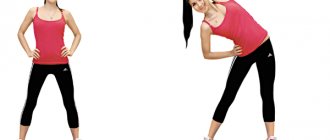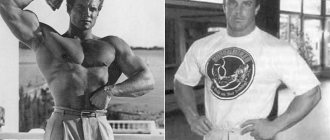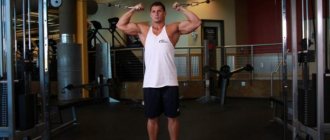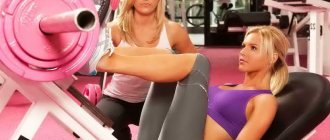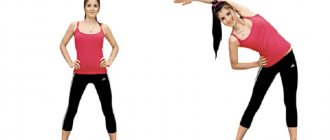| ATHLETE.RU :: Forum :: Books | Settings |
Return to contents Next chapter >>>
Main working muscles
:
Pectorals, deltoids, triceps
Short description:
Lie on your back on a bench, grab the bar with your arms outstretched, lower it to your chest, then lift it up again.
Preparation
When bench pressing inside a power rack, make sure the restraints and hooks are at the correct height. Limiters are the horizontal cross members between the frame posts. The limiters are fixed at a certain height of the racks using small pins. Alternatively, you can press using a strong, stable squat rack equipped with restraints. Otherwise, use half racks or combination racks. Some combination racks have adjustable stops. If you decide on one of these racks, then set the limiters at the appropriate height and position yourself on the bench so that you will not miss the limiters if you are forced to place the barbell on them during a set.
The bar tends to roll or slide against the stops. To prevent this, place a piece of garden hose on each stop, after cutting it lengthwise. This will also help you reduce metal clanging and vibration. However, if you control the bar correctly, you won't make much noise anyway.
If you can't find any bench press equipment that will allow you to lower the barbell to the racks in the down position if you fail to complete the next rep, you should
ask an attentive and strong person to “insure” you.
Place a strong, stable bench exactly halfway between the two posts. If you do bench presses in a power rack, you can even mark the position of the bench on the floor. Use a tape measure to make sure the bench is exactly in the middle.
Don't do bare-chested bench presses. Wear a T-shirt.
If you do regular touch presses with the barbell in the starting position at the top, then install the stops or bars 2-2.5 cm below the level of your chest as you inhale. Then, if you get “crushed,” simply lower the barbell down, exhale and place the bar on the stops.
Power frame and its accessories: two hooks (on the rear racks), four stops and four small pins (at the bottom), two pieces of hose.
The rack press from the bottom is a little different in this regard from the standard touch press. Set the stops exactly to the height at which the bar, if you lower it onto them, only lightly touches your chest as you inhale.
It is possible that the pitch at which the holes for the stops are drilled in the frame posts will not allow you to install them exactly at the height you need. For example, you want to raise the restraints 2.5 cm from the chest, but the holes in the posts are in 5 cm increments. In this case, you have only one thing left: place the restraints higher, at the same time
raising
bench
by 2.5 cm. This can be done by placing a rubber mat or thin board under the legs of the bench. This way, you will ensure that there is exactly 2.5 cm between your breasts and the restraints.
If installing the restraints at chest height causes you to feel discomfort in your shoulders, then do not be afraid to raise the restraints a few centimeters higher. Then, as your shoulders become more comfortable with the load, gradually lower the restraints over a couple of months to regain full range of range.
Position yourself on the bench so that your barbell or plates do not touch the racks or frame stops when you press the barbell up.
If you are doing the bench press in a normal manner, from the top starting position, then make sure that the hooks under the bar are positioned correctly. They should not be located too low or too high. At the beginning of each set, your assistant or partner should help you remove the bar from the racks. At the end of the set, you will again need help returning the barbell to the racks.
Due to the fact that during the lift in the bench press the barbell moves not only vertically, but also horizontally, the bar can hit the vertical posts that hold the hooks. On the other hand, if you position yourself at the correct distance from the hook racks and don't hit them with the bar as you lift, you will have a hard time removing the barbell from the hooks before your first rep.
If you don’t have an assistant or partner to help you remove the bar from the racks before starting the set, then train the bench press from the bottom position - this way you can completely forget about the problem with hooks. If you're bench pressing from a power rack, you don't need help at the beginning or end of the set.
When pressing from the bottom, set the restraints at chest level. When doing a touch press, the restraints should be set 2-3 cm below chest level.
You should lie securely and steadily on the bench. Legs, hips, back and head must be firmly fixed. To remove dangerous stress from your lower back, reduce the distance between it and the bench. Place pancakes or a block under your feet. However, I do not recommend that you put your feet on the bench - this sharply reduces your stability. The height of the block under your feet depends on the length of your legs and the height of the bench. If you are a person of average height, try placing a 10 cm high block under your feet. Use either one large block or two small ones for each leg. Your feet should be spread wider to improve stability. (Powerlifters should begin to gradually get used to arching their backs to press with competition form a few weeks before competition—but keep arching their backs to a minimum).
When the bar is in line with your lower pecs, grab it with a grip such that your forearms are perpendicular to the floor when looking at them (ask your assistant to look at them) like
from the side
and
from the legs.
Your elbows should be directly under your wrists. Adults may
want to try using a 54cm (54cm) grip between their index fingers to start with Women should narrow this distance by 10 cm. Based on these numbers, find “your” grip width at which your elbows and forearms will be in the correct position. Once you find the optimal grip width for you, have someone measure the distance between your index fingers and write down this number.
Do not use the so-called "open grip" because it will not allow you to control the barbell properly. The palms should be located at the same distance from the center of the bar. Handle the bar very carefully, making sure your hands are symmetrical to the center of the bar. Even before the set begins, you should know exactly where your hands should be. If necessary, use a tape measure. If you practice at home, you can even mark the desired spot on the bar (perhaps using a tape measure).
Open grip on the left and correct grip on the right
"Hands of Titan" Stuart Mac Robert.
From the author
Anyone who has already become the owner of a 40-centimeter girth can immediately turn to the second part of the “manual” course - the program for experienced ones.
But since there are probably few of them, I advise most to carefully study the first part and not put the cart before the horse. My friend Flynn's hall is a real iron paradise. What's there? I'll tell you now. Dumbbells - from the lightest to 90 kg. Eight power racks with restraints, four platforms for deadlifts and Olympic lifts. Twenty Olympic barbells with a full butt. Eight press benches, two pull-up bars, four curved bars, two pairs of push-up bars, two standing and seated calf raise machines, four high lat pulleys, two grip machines... and nothing else. Flynn has his own theory about this. He believes that the hall should not be cluttered with unnecessary equipment. Otherwise, you will provoke the client to “deviate” from useful basic exercises and become interested in easier, but ineffective training. “Okay, let’s say I put a hack machine and a leg extension bench here,” Flynn says. - I don’t feel sorry, let them stand. But some lost soul will definitely start using them! And in general he will stop doing normal squats! It turns out that I drove the poor fellow into a trap myself! Yes, my conscience will torture me! In short, this is how Flynn is: like, if you take up pitching, then do it for real! For clarity, I will tell you one true story. About a year ago, a teenager came to Flynn’s gym, absolutely crazy about the volume of his upper limbs. Five days a week the guy tormented his hands. Somewhere around fifty sets for biceps, the same number for triceps, and as an additional “trick” - 15 sets for forearms. All this is generously flavored with trisets, supersets, giant sets, complex sets, pre-exhaustion, negative reps, etc. and so on. “Would you like to try an old, proven system that has helped many of our clients?” — Flynn offered him from the bottom of his heart on the very first day. But the guy politely refused: they say, thank you, of course, but I trust my “forced program” more... Well, no, no trial. For six weeks, Flynn watched the poor man's suffering and finally decided to make a second attempt. I waited until he completed another two-hour marathon of hammering biceps and triceps, and asked: “
Well, eccentric, how are you doing on the manual front?”
“I just wanted to consult with you,” the guy responded. Something doesn’t work out for me, although I do everything exactly according to the plan... “No wonder,” Flynn thought to himself and silently took a sip of his coffee. - Maybe you can help me? “Not a bad idea,” Flynn agreed. “When you’ve fallen into stagnation, it’s time to think about changes...” “Probably need to add a couple more sets of barbell lifts,” the guy was inspired. — Superset with extensions on the lower block! AS NECESSARY
Flynn fortified himself with another sip of coffee, mentally counted to ten, took a deep breath and said: “No, I want to offer you something completely special.”
- So, do you have your own technique for your hands? “Of course,” Flynn nodded. Top secret. Only for club members! - Maybe you can tell me right now? - the guy asked, looking at Flynn the same way my dog looks at me when I eat the cutlets my wife cooked. “DOSSIER” OF THE CLIENT
Flynn began to carefully collect information: “How much do you bench press?”
“Five times 55 kg, but I rarely do this,” the guy answered. — I don’t want my arms to be “shaded” against the background of my chest and shoulders. - Clear. What about squats and deadlifts? - I never do them at all. And then, exercises for the legs and back are very tiring. And I need to save strength for my biceps and triceps! Then the conversation turned to food. Although nutrition is a strong word: the guy ate almost nothing, except for some ultra-modern dietary supplement from anabolic-metabolic optical-neuro-granular amino-activators. “If you want to look like a champion, you need to eat like a champion,” the guy explained to Flynn. “That’s true,” Flynn confirmed with the most serious look. “DOSSIER” OF THE PROGRAM
Flynn sent the guy to change clothes, and he sat down at the table and wrote out the training program for him.
Fifteen minutes later, our hero returned for the “secret technique.” He took the piece of paper, read it from beginning to end, then re-read it again and stared at Flynn in shock. - Where are the biceps curls? And triceps extensions? Flynn already had an answer ready: “This is a new super-scientific system.” Based on the principle of neuro-bio-optimization. Simply put, HBO. Many champions go crazy about it. - But why are there no biceps curls at all? “Molecular refraction,” Flynn responded casually. — Biceps curls are nonsense these days. Hands, remember, must be built at the atomic level!.. The “scientific” explanation convinced the guy, and he decided to try a new program. Although I was unpleasantly surprised when I found out that I would train only twice a week. FIRST STAGE TRAINING
“Our methodology is a serious thing,” Flynn said.
“So you have to start slowly and gradually.” On Monday you will do three exercises: squats, bench press and rows. On Friday - four: deadlifts, shrugs, pull-ups and bench press with a narrow (40 cm) grip. Your task is to become twice as strong. And to do this, you need to limit the volume of training and focus on basic exercises. They are the ones who build strength. You will work according to the 5x5 scheme. I'll explain what this means. You do five reps with a light weight. This is your first “warm-up” set. Then the second one - you add weight and do another 5 repetitions. Then you increase the weight again and do three “working” sets. And so on in every exercise. Later, by the end of the program, your “working” sets will be so difficult that you can’t even dream of now. But you need to start easy, and increase the “working” weights gradually - from week to week. The general picture is this: a month of relatively light training, then two months of hard training. The “easy” period is very important - it is a kind of “introductory course” and your insurance against injuries. If you immediately grab heavy weights, you will get stuck halfway through the program. You said you bench press 5 reps of 55kg? So, your twelve-week bench press cycle will look like this,” Flynn began to write a cycle diagram on a piece of paper. Weeks 1 30x5 36x5 45x3x5 (3 sets of five reps) 2 31x5 40x5 47x3x5 3 34x5 43x5 50x3x5 4 36x5 45x5 52x3x5 5 38x5 47x5 55x3x5 6 40x5 50x5 56x3x 5 7 40x5 52x5 58x3x5 8 40x5 55x5 61x3x5 9 40x5 55x5 63x3x5 10 40x5 55x5 64x3x5 11 40x5 55x5 65x3x5 12 40x5 55x5 66x3x5 13 40x5 55x5 67x3x5 “In the same way, you will increase the weights in all other exercises,” Flynn finished. Keep in mind: an advanced or experienced guy would not be able to increase the load at such a pace. This is only possible for beginners. NEW DIET
Under Flynn's leadership, the guy buried supplies of his “super supplement” in the yard.
I wonder if the grass will wither over this grave? - Flynn and I wondered. (As it turned out, it withered). Since then, the only supplement our young friend took was vitamins and minerals. And then one tablet a day. But in general, his diet consisted of natural, high-quality food: eggs, milk, cheese, meat, fish, pasta, bread, potatoes, vegetables and fruits. He ate hearty meals four to five times a day. As soon as I felt hungry, I immediately swallowed something solid. And he washed it down with one or two glasses of milk. - So, does everyone have to eat like this? - I asked Flynn. - No, only young and thin. But a man over thirty can limit himself to three meals a day: a good breakfast, a hearty lunch and dinner. The main thing is to eat high-quality, healthy foods. And get all your nutrients from them, not from supplements. As your training gets heavier, you also need to eat more to provide your growing body with everything it needs. Three months later, the guy added 13 kg in the bench press, 18 in the squats and 20 in the deadlift. In addition, he himself gained 4.5 kg - only due to muscles. Flynn told him that things were looking up and it was time to move on to the second phase of the program. But first, ten days of complete rest. SECOND STAGE TRAINING
Ten days later, Flynn and the guy met again. Flynn slammed the piece of paper with the new program onto the table with his wide palm. — In one secret laboratory, a shock technique was recently invented. Of course, they keep it strictly secret. But we have our own people everywhere. Long story short, we found a guy who cleans up trash in the lab, and he sold it to us for 50 bucks. So, at the second stage we will use a strictly new technique,” Flynn told the guy. - So what, am I going to do biceps curls and extensions now? - he was delighted. “No,” Flynn shook his head. — Our first task is to optimize metabolic factors. And the guy was hooked again: Flynn put him on three workouts a week with the 5x5 system for all basic exercises: Monday:
- 1. Squats (to parallel): 5x5 2. Bench press (65 cm grip): 5x5 3. Pulldown on the upper block (to the chest): 5x5 4. Seated overhead press: 5x5 5. Standing calf raises: 2x20 (weight unchanged) 6. Twisting: 1x40-50
Wednesday
- 1. Incline bench press (45 degrees): 5x5 2. One-arm dumbbell row: 5x5 (for each arm) 3. Barbell shrugs: 5x5 4. Crunches: 1x40-50 5. Side bends 1x30-40 (each side)
Friday
- 1. Squats to parallel: 5x5 2. Bench press with a narrow (40 cm) grip: 5x5 3. Deadlift on bent legs: 5x5 4. Seated calf raises: 2x20 (weight unchanged) 5. Crunches: 2x40-50
“Since Friday is the second squat day of the week,” Flynn explained, “the weight should be 20-30 percent lighter than Monday.” And don't be too zealous. At the end of each workout, the guy hung on the pull-up bar for as long as he could. This is a great exercise for strengthening your grip and also relaxes your back. Three months later, our fighter added another 3.5 kg of muscle and began to conquer some pretty serious weights. Flynn decided it was time to take him to the third stage of the program. Naturally, after a ten-day break. THIRD STAGE TRAINING
“We're moving on to a new blitz pumping system,” Flynn said. -Ultra-modern thing. All the big guys work on it. — Will I do biceps curls? — the guy asked hopefully. “Not yet,” answered Flyin. -It is necessary to vascularize the lobotomy. - Oh yes, I heard something about it. Flynn again switched the guy to a regime of two workouts a week, but this time using the 5x6 system - for all key exercises. This means five sets of six repetitions: three “warm-up” sets with increasing weight and three heavy “working” sets. Monday
- 1. Squats (to parallel): 5x6 2. Dips: 5x6 3. Pull-ups (palms facing away, medium grip): 5x6 4. Shrugs: 5x6 5. Standing calf raises: 4x10-15 6. Crunches: 1x40- 50
Friday
- 1. Deadlift: 5x6 2. Bench press: 5x6 3. Row on the upper block downwards (to the chest): 5x6 4. Seated barbell press (from the chest): 5x6 5. Raises on the toes while sitting or with a partner on the back: 4x15- 20 6. Twisting: 1x80-100 (without weights)
As in the second stage of the program, at the end of each workout the guy hung on the bar. But now Flynn wrapped a towel around her to make it more difficult to hold on. Our hero had no problems with his shoulders, so he could do push-ups on the uneven bars without the risk of injury. Naturally, subject to the correct technique. But Flynn warned: if anyone has shoulder pain, don’t go near the bars at all! Instead, do bench presses with a close grip. As for the diet, the guy very quickly forgot about the “buried” amino activators. He ate what Flynn recommended. By the end of the third stage of the program, he had added another 3 kg of muscle, his bench press had become “heavier” by another 13 kg, and his squats and deadlifts had increased by 18 kg. I must say, the guy has changed a lot in appearance. He got big! And the girth of his arms has grown by 6.5 centimeters! “Nothing surprising,” Flynn said when the guy reported to him about his victories. — Our old, proven program always works! FLYNN'S NOTE
Would you like me to tell you the “secret” to the success of my arm program?
In fact, everything is very simple. You can't build bigger arms until you gain overall muscle mass. And for this you need to do basic exercises: squats, bench press, deadlift, pull-ups, push-ups and presses. And at the same time increase the weight of the burden - gradually and constantly. That's all, actually. If you really want, you can include several sets of barbell curls in the program. But you don't need special exercises for triceps. They only injure the elbow joints. Remember, the bench press is the most important exercise for the triceps! Push-ups and standing chest presses also work them well. So, forget about stupid isolation exercises! Train basicly, get plenty of rest, eat healthy - and your arms will naturally grow to 40 cm or more! And finally, advice for beginners and advanced people - everyone whose arms have not yet reached 40 cm in girth. Don't think about biceps and triceps! Don't worry about the little things! Do basic exercises to build your muscle foundation. And slowly but surely increase the weight. Trust my experience: if you add 45 kg in squats and 35 kg in bench press, your arms simply cannot help but grow 4-6 centimeters! INTRODUCTION BY STUART MACROBERT
Having built your arms with a girth of 40 cm, you can go to the next level of training - specialized.
Most of the specialized programs that are now published in magazines are completely unsuitable for the average, “non-chemical” bodybuilder. Don't waste your time - don't buy into the promise of rapid progress. Before starting any specialization, gain strength and build muscle. To start working specifically on your arms, you should already be bench pressing 130-135 kg, squatting 170-180 kg and deadlifting 215-225 kg. And your arms should be about 40 cm in girth. Only with such “initial data” can you begin a specialized program. SUPERPROGRAM.
Flynn's lecture recorded by Stuart McRobert. “Let’s start with the main thing,” Flynn told me.
- Be especially careful here, this is very important. The program is designed ONLY for experienced guys. That is, those who bench press 135 kg, squat 180 kg, and deadlift all 225 kg. If you haven't mastered these weights, don't even think about specialized programs - neither for the arms nor for any other part of the body. In this case, the only thing you need is basic training. That's all! If you decide to specialize too early, you will definitely overtrain. What do they print in magazines?! Think about it: they recommend 20-30 sets for biceps and triceps! Yes, you should be put in jail for such “advice”! It’s clear to us, the “bisons” of pumping, that all these sets definitely come with a syringe of steroids in the ass. Well, naive beginners take such recommendations at face value and seriously hope for results! I repeat, this program is only for experienced ones! If you are not one, work according to the method for beginners. And put off specialization until you become really strong! PHASE 1
“The program is divided into two phases,” Flynn continued.
— The first phase is three training sessions per week: Monday, Wednesday, Friday or Tuesday, Thursday, Saturday. And so no more or less than 12 weeks in a row. Then phase number 2 begins. During this phase, as, indeed, any other phase or program, you should first of all think about increasing the “working” weights. Because your task is to become stronger. At the same time, I guarantee that you will not only become stronger, but also add mass. And all because one without the other is simply impossible. - Do you see those little pancakes over there? We have about fifty of them scattered around the hall. Each - half a kilo. This is exactly what I mean when I talk about increasing weight. That is, you need to add a little to the bar. You start off easy - with a weight of 79-80 percent of your maximum for a given number of repetitions. You enter the program slowly, increase the intensity gradually, so that you reach the maximum by week five or six. If you want progress, you must not only increase the intensity, but also get enough rest and, as they say, eat heavily. Remember: to grow strength and muscle, the body requires normal natural foods, not supplements! In short, eat as much as you can, but eat less fat! Mondays
- On Mondays you will not do any specifically “manual” work.
Only basic exercises aimed at increasing muscle growth throughout the body, including the arms. The secret to a specialized program is to combine “special” training with basic training. So, if you decide to increase the volume of your arms, be prepared to gain from 2 to 4 hectares of total mass. On Monday, the workout begins with squats. First, you do 2 sets of 8 repetitions to warm up. The first one is light, the second one is a little heavier. Keep in mind: warming up should be really easy. Save your strength for the third set. Once you're halfway through the phase, this third set will consist of 20 as heavy reps as possible. The weight is what you can bear. Inhale deeply several times between repetitions. Do you get the point? Absolutely: this is the same old-fashioned heavy squat program that turns a boy into a husband. Start easy, but work your way up to 150% of your body weight. After squats, move to the bench, lie down and do a set of breathing pullovers with light weight. When I say “easy”, this is what I mean. The bar weighs 7 kg - quite enough even for a superman. If you take more, the muscles will be forced to contract too much and “pinch” the chest. This means that you will not be able to “expand” your breasts as required. The main thing in such pullovers is deep breathing, and not overcoming the weight. And be sure to lie along the bench, as if you were doing a bench press, and not across it, with your butt hanging down! This overstretching weakens the abs. When you reach maximum weights (in the second half of the phase), rest for 15-20 minutes after squats and pullovers. If the squats are done properly, you simply cannot do without this break. If you feel like you can do it without rest, that means you sucked at squats. After the break, you will do bench presses and rows on the upper block downwards - 5 sets of 6 repetitions in each exercise. But not with a superset! First all the bench presses, then all the deadlifts. Start with a light set, then add weight and do a second warm-up. And the final three are with “working” weight. Rest for at least three, preferably five, minutes between heavy sets. Let's move on: crunches, one set, 20-30 reps with a heavy dumbbell on the chest. After that - two sets of calves. And finally - work on the grip and forearms. Hang on the bar until you fall, or squeeze a rubber ball non-stop for three minutes until your fingers turn blue. Wednesdays
- Wednesdays are exclusively “manual” training.
A very important part of the program, but requires great care. Such a load will immediately knock a beginner or even an advanced person off their feet. And even an experienced one can inadvertently injure himself. The main thing is to “enter” the program slowly and carefully. The first four weeks are the “getting started” period. This is vital! So, on Wednesday, training begins with seated dumbbell presses: 5 sets of 6-8 repetitions. It’s good if you have a bench with a high incline at hand - 80-85 degrees. Do the press synchronously, with both hands at once: no alternating nonsense. If you want, you can press from behind your head, but on the same bench - it “unloads” the lower back. The first set is easy, the second is a little harder, and the final three are hard. If in the last set you squeeze out 4-6 repetitions, then the weight is as it should be. And if you can do more than six, it’s time to increase the weight. This press is a great exercise for the triceps. No, you heard right: specifically for triceps! You will see that in the program there are no extensions, no presses - no “isolated” work on the triceps at all. The reason is simple: triceps grow from heavy bench presses. And isolation is pure pampering; it doesn’t add a single centimeter to the triceps. The second exercise on Wednesdays is the biceps curl. You will do 5 sets of 6-8 repetitions, the scheme is the same as for bench presses. Take the neck you like: you want a regular one, you want a curved one. Watch your technique, control the weight both when lifting and lowering. Take deep breaths between repetitions. Keep your elbows close to your sides to prevent them from moving during the toughest parts of the climb. And, as with bench presses, aim for very serious weights. The barbell curl is the best, unrivaled biceps exercise. Work on it properly and you'll see what I mean. The third point is the close grip bench press. The distance between the thumbs is about 40 cm. Here again, 5 sets of 6-8 repetitions. If you have an EZ bar, it will come in handy for this exercise. This press, combined with the overhead press, gives an absolutely killer load on the triceps. Next on the agenda is lifting the barbell with a reverse grip or “hammer” - 5 sets of 6-8 repetitions. These exercises challenge the biceps and forearms from a different angle, and therefore provide a powerful stimulus for growth. If you do some variation of a regular lift instead, you will get nothing but overtraining. The workout ends with work on the forearms and grip - the same as on Monday. After the fourth week, train as hard as you can. Try to use serious weights: 70-75% of your own weight for biceps curls, for presses - your own weight, for close-grip presses - 125% of your own weight and half of your own for reverse-grip curls. But remember: you need to move towards these scales slowly, gradually. Fridays
- The first exercise is weightlifting, your choice.
Deadlift, regular or straight legged, or push - whichever you like best. If you choose stiff-legged deadlifts, do 4 sets of 8 reps. Start easy, add more load with each set. The final set is the hardest. For regular deadlifts or snatches, do 5 sets of 5 reps, the load increases the same way. I advise you to do the push only if you are well familiar with the technique and there is a specialist next to you. The fact is that the push is technically more difficult than the pull. And if there is no intelligent assistant nearby, it is better not to take on him. Next comes shrugs with a barbell, 4 sets of 8 repetitions. You start, as always, lightly, adding weight with each set. The last set is with your maximum for 8 reps. The next exercise is dips, one set, 20 reps. Do them very clearly so as not to damage your shoulders. Don't swing - it's dangerous and ineffective. And don't overextend at the bottom, or you'll end up in trouble. The first few repetitions are very slow and careful; do not reach the full amplitude right away. If you have or have had problems with your shoulder joints, forget about this exercise altogether. Instead, do push-ups, but with your legs elevated to increase the load. Or push-ups. You place two benches opposite each other, at a distance of about one and a half meters or a little less. You place your heels on one, and grab the other with your palms behind you. And you begin to move up and down, bending and straightening your elbows. If you want to add load, ask your partner to put a pancake weighing, say, 40 kg on your hips. But only one, not four for 10! They will definitely fall off, and then you can say goodbye to your manhood. One set of 30-40 repetitions was done until there was a good burning sensation in the triceps. After that, you move on to pull-ups. The palms are turned towards you, the grip is narrow - 15-25 centimeters. Slowly and measuredly do 15-30 repetitions - depending on your own weight. Some are lighter - 15, some are heavier - 30. When all the repetitions are easy, hang a weight from your belt - for starters, 10 kg. The workout ends with two or three sets of calves, one set of crunches (30 repetitions, with a dumbbell on the chest) and grip work (10 minutes). - The first phase lasts 12 weeks, after which you move on to the second, short one - only 3 weeks. Here, 95 percent of the time is devoted to specifically “manual” work. The remaining five percent are squats and deadlifts. On Friday of the first week - 5 sets of squats, on Friday of the second - 5 sets of deadlifts, and on the third Friday - 5 more sets of squats. Here you work according to the “5x6” scheme - two warm-up sets with increasing weight, and three heavy ones - for a maximum of 6 repetitions. For example, for a guy who squats 6 reps with a weight of 170 kg, the scheme would look like this: 113x6, 147x6, and three sets of six reps with a weight of 170. Rest 5 minutes between heavy sets. Deadlifts can be done with straight or bent legs - whatever you want. The arm complex in the second phase consists of the same exercises that you did on Wednesdays in the first. On Mondays and Fridays the complex is exactly the same as on Wednesdays in the first phase. But on Wednesday the number of repetitions changes: no longer 6-8, but 8-12. There are five sets: two warm-up sets with increasing weight, three heavy ones. Try to take a weight that is 70-75 percent of the maximum with which you did 6-8 repetitions in the first phase. In addition, on Wednesdays you will do a set of push-ups (the same as on Fridays in the first phase) and a set of close-grip pull-ups. There is no need for weights: the main thing here is as many repetitions as you can. Write down the number of repetitions and every Wednesday try to do 2-3 more than before. GENERAL VIEW OF THE PROGRAM
“When you finish the second phase,” Flynn continued, “you will take a “vacation” for 10 days.
After this, you will return to the training of the first phase and “sit” on them for 6 weeks. Start easy, don’t rush into battle for the first two weeks, lift heavy weights only in the last 4 weeks. Then repeat the second phase. After it - again 10 days of rest. And move on to a more balanced training program built around the squat, bench press and deadlift. It looked like Flynn was wrapping up his lecture. - If you really want to build big arms, go through this program once a year. And you don't need anything else. Just remember to constantly increase the weights. If you work with the same weight, your arms will become “preserved.” ADVANCED PROGRAM: PHASE 1
Monday
- 1. Squats to parallel: 1x8 (light weight), 1x8 (medium), 1x20 (heavy). 2. Breathing pullovers: 1x30 with a bar weighing 7 kg (no more!) 3. Break 15-20 minutes 4. Bench press: 1x6 (light weight), 1x6 (medium), 3x6 (heavy) 5. Rows: 1x6 ( light weight), 1x6 (medium), 3x6 (heavy) 6. Crunches: 1x20-30 7. Calves 8. Grip
Wednesday
- 1. Overhead press (dumbbells or barbell) on a bench at an angle of 80 degrees (if possible): 1x6 (light weight), 1x6-9 (medium), 3x6-8 (heavy) 2. Barbell curl: 1x6 ( light weight), 1x6 (medium), 3x6-8 (heavy). 3. Bench press with a narrow (40 cm) grip: 1x6 (light weight), 1x6 (medium), 3x6-8 (heavy). 4. Raising the barbell for biceps with a reverse grip or “hammer”: 1x6 (light weight), 1x6 (medium), 1x6-8 (heavy) 5. Grip
Friday
- 1. a) Deadlift on straight legs: 4x8, start easy, gradually increase the load, the last set - with a maximum of 8 repetitions or b) Regular deadlift, or clean and jerk: 5x5, increasing the weights as in the previous exercise. 2. Shrugs with a barbell: 4x8, start easy, gradually increase the load, the last set is a maximum of 8 repetitions. 3. Push-ups on parallel bars: 1x30 or push-ups from the floor (legs raised): 1x30 or push-ups from the bench: 1x30-40 4. Pull-ups with a narrow (15-25 cm) grip with palms facing you: 1x15-30 5. Calves 6. Crunches: 1x30 7. Grip
ADVANCED PROGRAM: PHASE 2
Monday The same complex as on Wednesdays in the first phase (naturally, the weights have “grew up”) Wednesday The same complex as on Wednesdays in the first phase, but with a different set-repetition scheme: 1x8 (light weight) , 1x8 (medium), 3x8-12 (heavy).
Plus: a) Push-ups (as on Fridays in the first phase) - 1 set to failure. b) Close-grip pull-ups (as on Fridays in the first phase) to failure, but without weights. Friday The same complex as on Wednesdays in the first phase Plus: a) in the first and third week - squats: 2x6 (warm-up), 3x6 (heavy) 6) in the second week - deadlift or snatch: 2x6 (warm-up), 3x6 ( heavy) GENERAL SCHEME OF THE PROGRAM
Phase 1:12 weeks (the first four are “introductory”, 8 are heavy).
Phase 2: 3 weeks Rest 10 days Phase 1: 6 weeks (2 weeks - “introductory”, 4 - hard). Phase 2: 3 weeks Rest 10 days, return to a balanced program. In the last stage of any program, whether experienced or new, you are required to rest, sleep and eat more. The final stage is a “new territory”, and it must be mastered fully armed. If you feel like you're "overloaded," you can eliminate work on your abs, calves, and even grip. Don’t forget: this is a program for experienced people, that is, those who have reached 40 cm in arm circumference, bench press 135 kg, squat 180 and deadlift 226 kg. If you haven't reached this level yet, work on the beginner program. ATTENTION! This manual includes a description of extremely intense training methods based on heavy basic exercises: deadlifts, squats, bench presses, standing and seated presses. Performing these movements carries the risk of injury and overtraining. Before starting training based on the recommendations in this book, you must undergo a medical examination! An indication for the use of difficult basic techniques can only be absolute health! Scanned by Pavel Lukashin (aka Pashtet)https://members.spree.com/sip/pashtex For errors, please blame my scanner and Fine Reader 4.0 BIG ARMS Copyright © 1993 by Brook D.Kubik and Stuart McRobert. All rights reserved. Cover illustration work by Eleni Lambrou, Copyright © 1993. Published by CS Publishing Ltd., Nicosia - CYPRUS © JV "Wider Sport", 1999 ISBN 9963-616-01-1 LR No. 065706 dated 03.03.98. Signed for publication on December 21, 1998. format 70×101/16. Offset printing, Offset paper No. 1. Print. l. 1. Circulation 15,000 copies. Order 89966. Wider Sport Publishing House. Printing house of JSC “Young Guard”.
Performing these movements carries the risk of injury and overtraining. Before starting training based on the recommendations in this book, you must undergo a medical examination! An indication for the use of difficult basic techniques can only be absolute health! Scanned by Pavel Lukashin (aka Pashtet)https://members.spree.com/sip/pashtex For errors, please blame my scanner and Fine Reader 4.0 BIG ARMS Copyright © 1993 by Brook D.Kubik and Stuart McRobert. All rights reserved. Cover illustration work by Eleni Lambrou, Copyright © 1993. Published by CS Publishing Ltd., Nicosia - CYPRUS © JV "Wider Sport", 1999 ISBN 9963-616-01-1 LR No. 065706 dated 03.03.98. Signed for publication on December 21, 1998. format 70×101/16. Offset printing, Offset paper No. 1. Print. l. 1. Circulation 15,000 copies. Order 89966. Wider Sport Publishing House. Printing house of JSC “Young Guard”.
Performing a bench press
After an assistant has helped you lift the barbell from the racks before starting the set, pause while holding the barbell above your chest with your arms outstretched to stop the barbell from swinging. Now retract your shoulder blades, i.e. try to squeeze them together, and immediately lower the bar while maintaining control over it. The descent should take approximately two seconds. The way you lower the bar will greatly influence the position from which you start lifting it.
Lower the bar to a point that is below the nipple line, i.e. to the lower edge of your pectoral muscles. Typically, this means that you will have to lower the barbell lower on your chest than you were previously doing. Determine exactly the point on your chest to which it is most convenient for you to lower the barbell. As noted above, when the bar is on your chest, your forearms should be vertical when looking at them like
from the side
and
from the front (or from behind, depending on where the observer is located). If your forearms are not vertical, then you are gripping the bar incorrectly.
Never perform a push press from your chest or from the rack restraints. Either simply touch the bar to your chest and then immediately press the bar up, or pause very briefly on your chest (or on the bars if you're pressing from the bottom of the rack) before pressing the bar back up. Either way, squeeze, tense your muscles, open your lats, and press the barbell upward powerfully.
In the figure below you can see approximate options for the trajectory of the barbell when lifting it in the bench press (the head is on the right). Both options assume that you have lowered the bar correctly to a point at or very close to the bottom edge of your pecs, and that your elbows are directly below your wrists. Experiment with both options or even find something in between and settle on what suits you best.
The first few centimeters of the rise should be vertical, or almost vertical. The only direction in which your barbell definitely should not
move is in the direction of the legs!
To ensure that the bar does not move even a millimeter towards your legs, raise its top, but not strictly horizontally, but slightly
towards your face.
Two options for moving the bar while lifting the barbell in the bench press. Your head is on the right. See text.
Take a video of yourself or ask someone to watch you from the side. What may seem like an initial vertical movement to you may actually be a subtle movement towards the feet. You may think that you are moving the bar slightly towards your face, but in fact you are raising the bar exactly vertical. Observing yourself from the outside will help you find out with complete certainty how you lift the barbell. Then, through trial and error, you can find exactly the trajectory for the first few centimeters that suits you best.
The rest of the upward amplitude can be passed in several ways. First, continue pressing the barbell in a straight line as you did during the first phase described above. This way, the bar will move almost vertically from the line of your lower pecs with only a subtle drift towards the head. The second option for the remainder of the amplitude, following the first phase described above, involves moving the bar towards your collarbones in a steep diagonal line, which then passes into the final, almost vertical phase either over your upper chest, or, in extreme cases, over your collarbones . Keep your forearms as perpendicular to the floor as possible during the lift. To do this, keep your elbows directly under your wrists.
In the first edition of the book, the drawing showed the trajectory of the movement with greatly exaggerated curves. However, because this trajectory can lead to shoulder discomfort for most people, it is much safer and more effective to lift the barbell along the trajectory given in this edition of the book.
The rise, just like the descent, must be symmetrical. The bar should be kept level in the center, the bar should not lean to one side, both hands should move in unison, and each half of your body should bear exactly half the weight of the bar. Distributing the load symmetrically is extremely important!
After locking the bar at the top, take a short break. Don't let the bar "drift" towards your face. Keep it where it ended up at the end of the climb, i.e. somewhere approximately between the middle of the chest and the collarbones.
When pausing between reps, keep your elbows fully straight. Keeping your elbows straight, move the bar slightly forward, away from you, until it is directly above the bottom edge of your pecs. Pause briefly to make sure the bar is stationary, squeeze your shoulder blades, and then slowly lower the bar to the desired point on your lower chest.
Inhale when the bar is at the top, hold your breath while lowering, and exhale as you rise. If you do presses from the bottom point in the frame, then inhale when the bar rests on the stops, or even take more than one breath at this moment, but several.
Flynn rummaged through the folder, looking for the second Chat program. “Aha, here it is!” He handed me a piece of paper. The second program, like the first, was designed for 12 weeks.
Monday
1. Squats: 5×5 2. Bench press: 2×5 (“warm-up” with increasing weight), then 5/4/3/2/1 3. Bent-over rows: 5×5 4. Crunches: 1×40
Wednesday
1. Seated dumbbell press: 4×6 2. Incline dumbbell biceps curl: 4×6 3. Seated calf raise: 2×10 4. Lateral bends: 1×15 (each side)
Friday
1. Deadlift: 5×5 2. Bench press: 4×5 3. Pulldown: 4×5 4. Incline (30 degree) dumbbell press: 4×5 5. Crunches: 1×40
“The 5/4/3/2/1 pattern,” Flynn said, “is another step in the transition to real heavy, low-rep training. I nodded. I'm familiar with this system. At one time I experienced it myself. So Chat isn't the only Flynn student to benefit from it.
“First,” Flynn continued, “you do a couple of warm-up sets. Then you move on to the “workers”. For the first one, you take enough weight to do five good reps. But not your maximum for five - otherwise you will immediately run out of steam. Then you slightly increase the weight and do the second set: four repetitions. In the same way - it’s hard, but not to the point of passing out. You add weight again and do a set of three reps. Then you add it again and press a set of two. You add more and do one last press. By the way, such a stepwise increase in load is a very useful thing, not only in terms of mass and strength! A guarantee that you will not end your life in a wheelchair.
— You didn’t allow him to immediately try training with his maximum weight? - Of course not. The whole point here is to completely forget about your best records for the first 6 weeks. No, you start “chest” training as if from scratch - with small, almost warm-up weights. Even in the last single set you are benching a clearly frivolous weight. But then you increase your load from workout to workout and by the end of the sixth week you are approaching your previous maximum. But this is where the real hard work begins. Remember: in order to jump high, you must first sit down a little.
It’s the same with training—strength does not grow linearly. To prepare for a power surge, you must first step back. This is the main law of any training cycle. You can’t start from your previous maximum! First, “squat down” in the sense of weights, and then begin to gain forward momentum, adding loads at each workout. Just imagine, you wouldn’t be able to add anything to your previous maximum—that’s why it’s a maximum. But if at the beginning of the cycle you reduced your training weights by 30-40 percent, then it’s a completely different matter.
So you move forward and forward little by little until, on this same inertia, you overshoot your previous maximum point. And again, I achieved a record - stop. Don’t even try to squeeze even more out of yourself - you’re already at the limit. On the contrary, drop the weights to a minimum, give your body a rest on these scales and little by little move forward again - to a new record.
— Well, what did Chat achieve at the second stage? “He surprised me,” Flynn said. “I knew that since the guy came off the daily bench press program, he must add at least 4.5 kg in his bench press.” And the transition to the 5x5 system guarantees an increase of another 4.5 kg. But Charlie exceeded all my expectations. By the end of the first 12 week program, when I allowed him to go for a personal best, he had bench pressed a maximum of 95kg! And this is a guy who hung on 80 kilograms for a year! Then he took a week-long “time out”, went through the very first program again, and by the end of it he brought his maximum to 101 kg! Yes, and besides, during the first cycle he gained 3 kg of muscle, and during the second - another 3. Which, however, is natural. It is impossible to increase strength in the bench press without adding mass.
— What happened after program number two? “In 12 weeks of the second program, he gained another 2 kilograms of muscle and reached a 108-kilogram bench press. Then again a week's respite, and the same cycle all over again. This time his bench press “grew” to 113 kg. In short, during the first year of training under my leadership, Chat increased 8 kg of “mass” and “weighted” his maximum in the bench press by 33 kilograms. This is great progress! Most amateur jocks would be happy with even half of this result! But Chat sat on his idiotic program for so long that his body really yearned for the transition to meaningful training. It simply could not fail to respond to a reasonably planned methodology!
In addition, Chat worked very seriously on his technique. The heavy bench press requires absolutely precise biomechanics. Well, then, of course, I explained to the guy what was what. The legs should rest on the floor with the entire foot, and the shoulders and butt should lie firmly on the bench, without lifting off. And then, the weight must be squeezed up and back, in an arc. Yes, yes, when bench pressing, the bar moves both vertically and horizontally. First you press up, then a little back - towards your face, and not strictly above your chest. And at the top point the fif is located above your eyes—or even above your forehead. And you need to lower the weight slowly and calmly, exactly where you need it: on the chest just below the nipples. Chat used to literally drop the barbell, and then “rip” it off his chest with a push. In a word, it is both dangerous and useless. Meanwhile, after each repetition you need to pause for at least two seconds.
Naturally, before, when pressing, Chat lifted his butt off the bench by ten centimeters - to “help” the barbell. I quickly weaned him off this. And from arching your back too. “Bending” is a surefire way to damage your lower back. True, powerlifters in competitions often arch their backs to shorten the path of the barbell. But this is a very dangerous technique, so you shouldn’t follow their example. And so that Chat would not “sag,” I slipped platforms under his feet that were the same 10 cm high. So he pressed with me with his legs raised. You kill two birds with one stone: you protect your lower back and give your body a chance to develop a more powerful force in the bench press.
And then, the guy got used to benching with an “empty” chest. I explained to him that before each repetition you need to take a deep breath, lower the barbell with full chest, and on the way up, at the most difficult point, exhale forcefully. In addition, like most dummies, Chat took the fife with a grip that was too narrow for his physique. I fixed this issue. And from then on, at the lowest point, his elbows stood exactly under his hands. And to make his grip stronger, he always sprinkled his palms with talcum powder. You can also wrap FIF-Fu-Boy tape - this will strengthen your grip. The main thing is that the grip is strong, durable, and reliable.
First of all, it's safer. And secondly, it increases self-confidence. Gives you a feeling of strength, and this is already half the success. And finally, I replaced the risky “no thumb” grip with a proven, safe one: the thumb clasps the hand and touches the index finger. And I also taught Chat the elbows versus lats technique. Most ignorant guys involuntarily flare their elbows when they bench press. And this is a very weak position. The fact is that when the elbows are apart, the lats are relaxed, but the secret is to press with tight lats. And they will tense up on their own if you keep your elbows closer to your body.
With rest between sets, Chat also had “the typical wrong” before. That is, he did not rest at all. Well, for me everything went differently: 3-5 minutes between heavy sets, and 5-10 between very heavy ones. “What about the strength “outfit”?” I asked.
“Chat wasn’t ready for this yet,” Flynn answered. “That is, he, of course, immediately put on the belt with us.” In general, I think that the belt is a very useful thing. Protects against injury at any stage of training. Chat bought himself a high-quality belt from a reputable company, not some cheap one. It is important that the belt is wide and made of very thick leather. There is no need to waste money on counterfeits: the stingy pays twice. But it was too early for him to put on a bench press shirt. Unless you are suffering from old injuries, there is no point in getting into the shirt until you have reached 135 or even 160 kg on the bench. It is better to build a muscle “base” without it. Same thing with wrist straps. And in general, in my opinion, even experienced ones should not get carried away with any “equipment” other than a belt. It is much more useful to train “on your own”, and wear T-shirts and wrist straps only for competitions in order to “spur” the result.
What else helped Chat was eating normally. Previously, he lived solely on supplements and egg whites. I advised him to quit nonsense and eat like a human being. Meat, chicken, turkey, fish, eggs, milk, cheese, bread, potatoes, rice, pasta, fresh fruits and vegetables—three to four times a day.
At the end of the year, Chat gained a lot in both strength and overall body weight. However, could it happen that all my cycles and schemes did not help him? Certainly. Luckily for him, he didn’t practice the multi-set approach for so long—no longer than 3 years. During this time, he did not have time to drive himself into absolute stagnation, or, as we say, “dry out” his muscles. But even if I had dried up, I would not have given up. I would reduce his workload even more. I would “prescribe” the following scheme: bench press and squats twice a week, 3x5 for each exercise. And that's it, period! 2 sets - warm-up, and one working set. Such a program will put the dead on their feet! The recipe is always the same: if there is no result, don’t do more—do less! In 99 cases out of a hundred, this works flawlessly.
Other Bench Press Tips
Apply chalk to your palms to improve your grip and grip on the bar. Keep the fingerboard checkering clean. In this case, your hands will not slide to the edges of the bar during the set.
Never turn your head while raising or lowering the barbell. If you do this, the barbell will tilt slightly to one end, you will “lose” the amplitude and, possibly, get injured.
If you are working in the frame from the bottom point, then before each repetition you should make sure that the bar rests symmetrically on the stops and that the distance between the bar and the vertical posts of the frame is the same on both sides. If necessary, an assistant should correct any imbalance between repetitions. But as you gain experience, if you lower the barbell in a controlled manner, you will be able to learn how to lower the barbell correctly onto the stops on each rep.
In this picture, the athlete is lowering the bar to the upper chest. NEVER DO THIS! Countless athletes have ruined their shoulders forever with this technique.
Using 50% of your maximum weight for a given number of repetitions, do several sets of 10 repetitions, comparing two different barbell lifts. Decide for yourself which trajectory seems more natural and powerful to you. Perhaps, to make a final decision, you will need to conduct more than one training session. Then over the course of a few weeks you should gradually return to your previous best weights. You may need even more time for this if before this your bench press technique was very different from the one I described above. And only after that
You can start conquering new weights and start building muscles.
New, correct technique will increase
your bench press results and
reduce
your chance of injury. But if you rush and return to the same weights too soon, you will ruin your new technique and start injuring yourself again.
Once you have learned a good new bench press technique and learned how to put it into practice, train yourself to prepare for the bench press and approach the barbell in the same and specific way every time. Having loaded the bench press bar, approach it and take your starting position on the bench as usual, but clearly, consistently and seriously. Ask your assistant or partner to watch your bench press from the side or videotape yourself. Please be sure to do this, because perhaps you are doing something wrong, although it seems to you that you are doing everything correctly.
When applying chalk to your hands, cover the entire surface of your palm well, including the area on the inside of your thumb and index finger.
Once you have learned your new correct bench press technique, you still need to be very careful about how you perform that technique on every rep. Never become arrogant and don’t think that even if you are distracted by something else, you are still doing everything technically. Without being 100% focused, you may lower the bar incorrectly or straighten one arm before the other. All this can easily unsettle you, i.e. correct trajectory of movement. The weight will seem overwhelming to you, you will not do the required number of repetitions, you will fall into despair and, possibly, get injured.
Insurance and assistance
The first useful function of the assistant is to help you remove the barbell from the racks at the beginning of the set. During a set, as soon as the barbell stops or begins to tip to one side, or if one arm begins to straighten faster than the other, or the lifter begins to arch his back or tries to lift one shoulder off the bench, an assistant should immediately intervene to prevent further breakdown of the technique, risking injury.
The stoppers must be secured in place with special pins that prevent them from falling out of the holes while you perform the set.
To better demonstrate the technique to you in the photographs in this book, we specifically shot the model without a T-shirt. In addition, as you can see, in the photographs the person is doing exercises without stands or restraints. This was done deliberately and for demonstration purposes only. When training, you should always wear a singlet and always take the necessary safety precautions - for all your exercises.
In general, one assistant is enough for training. For maximum single attempts, it is better to have three assistants - two standing at the ends of the bar, and one in the center. If there are three assistants, they must act in concert. If one belayer gives a command, then everyone must join.
Three assistants are needed so that they can remove
the barbell from you, if suddenly the need arises. However, keep in mind that if there are several assistants, their assistance will most likely not be coordinated with each other. Therefore, you should not do forced repetitions with three assistants, because... there is a high probability that the athlete will lose his trajectory and get injured.
If you have invited one assistant, then he must belay with both hands and apply enough force to the bar to maintain a horizontal position of the bar and provide you with symmetrical assistance.
Even if the lifter is not performing forced reps, an assistant should still help the lifter rack the barbell after the last rep. At the end of a difficult bench press set, you will be very tired. It will not be easy for you to place the barbell on the racks without an assistant guiding the bar in the desired direction.
If you do presses from the bottom point in a power rack, then you do not need racks. This way, you don't need an assistant to remove the barbell from the racks at the beginning of a set and put the barbell back on the racks at the end of the set. However, even in this case, the help of a spotter will be necessary: if the barbell has dropped onto the stops off-center, he will be able to correct it between your repetitions.
